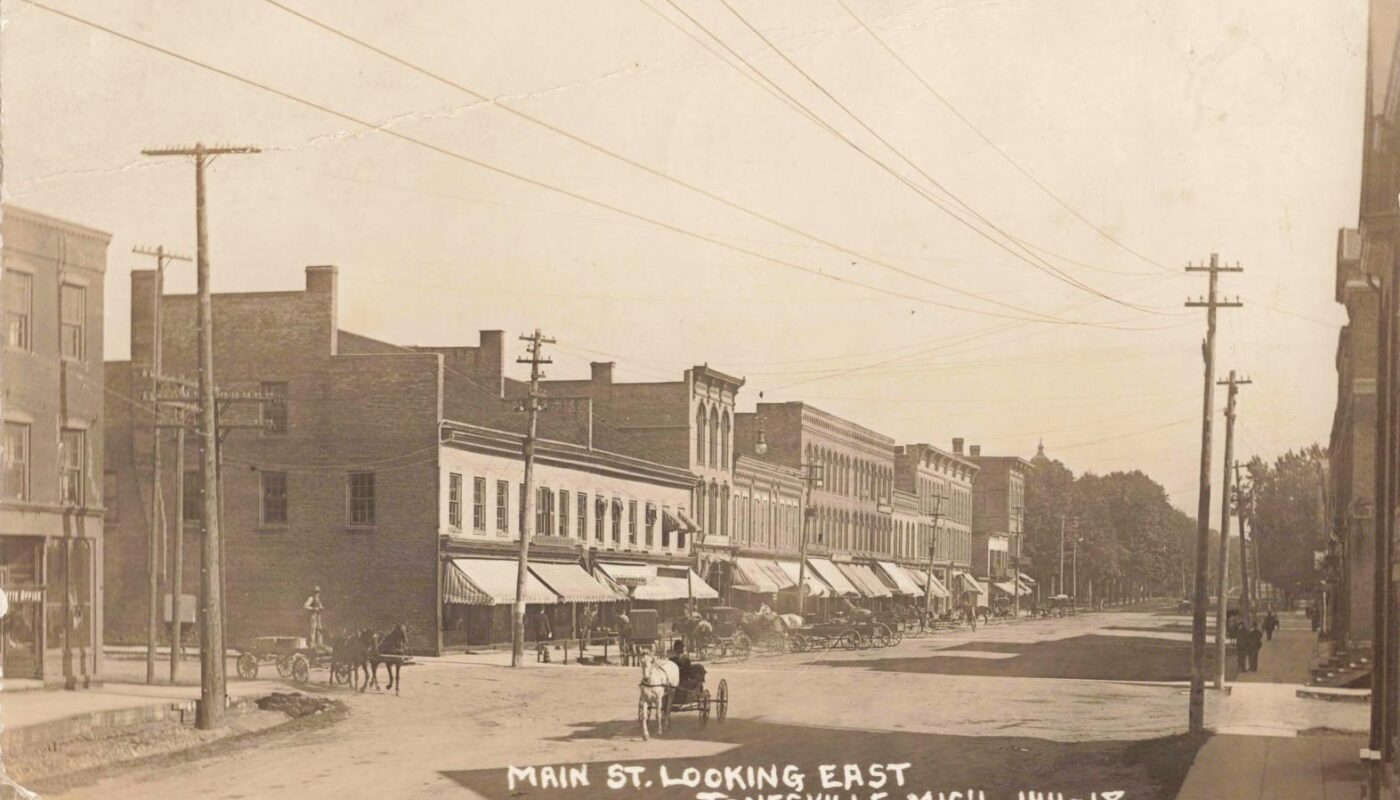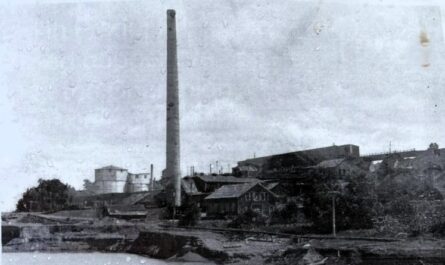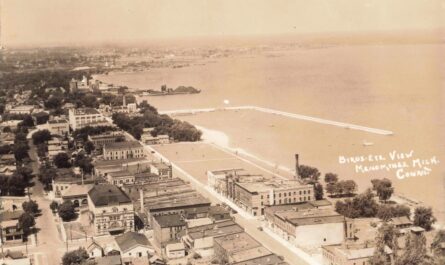The history of Jonesville Michigan began in 1828 when brothers Benaiah and Edmund Jones settled on the St. Joseph River. By 1831 the village was platted and it became Hillsdale County’s first seat (1835–1841). The community incorporated in 1855. In the late 1800s a railroad line was built through Jonesville. The Lake Shore and Michigan Southern Railway ran an east–west route past the town, and Jonesville “once contained a railway station along” this line. The station and depot (photo below) made Jonesville a rail shipping point. Main Street (US-12/Chicago Street) grew up around the tracks, linking small factories and shops.
Video – Marl, Motors, and Main Street – Jonesville’s Big Ambition
Jonesville Was A Town On The Move
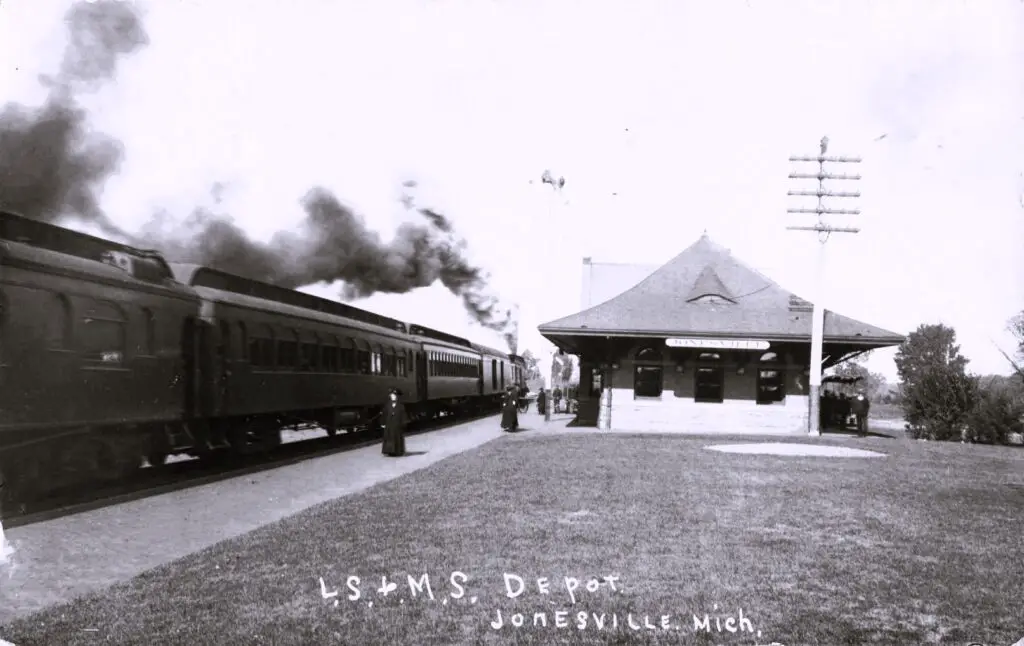
Early 1900s Jonesville was a busy village of roughly 1,300 people (population rose from 1,307 in 1900 to 1,396 by 1910). Streets were lined with two-story brick storefronts.
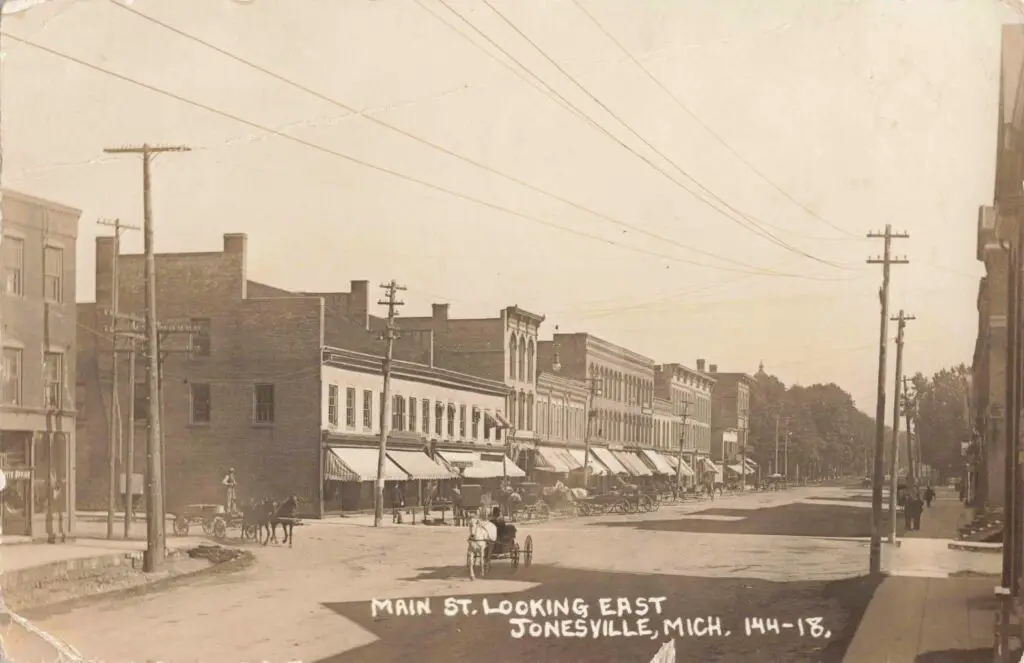
A local newspaper, the Hillsdale Gazette, had begun publishing in Jonesville as early as 1839. The Gazette’s printing office, shown in a 1909 photograph, fronts on West Chicago Street (the old City Hall and firehouse stood nearby).
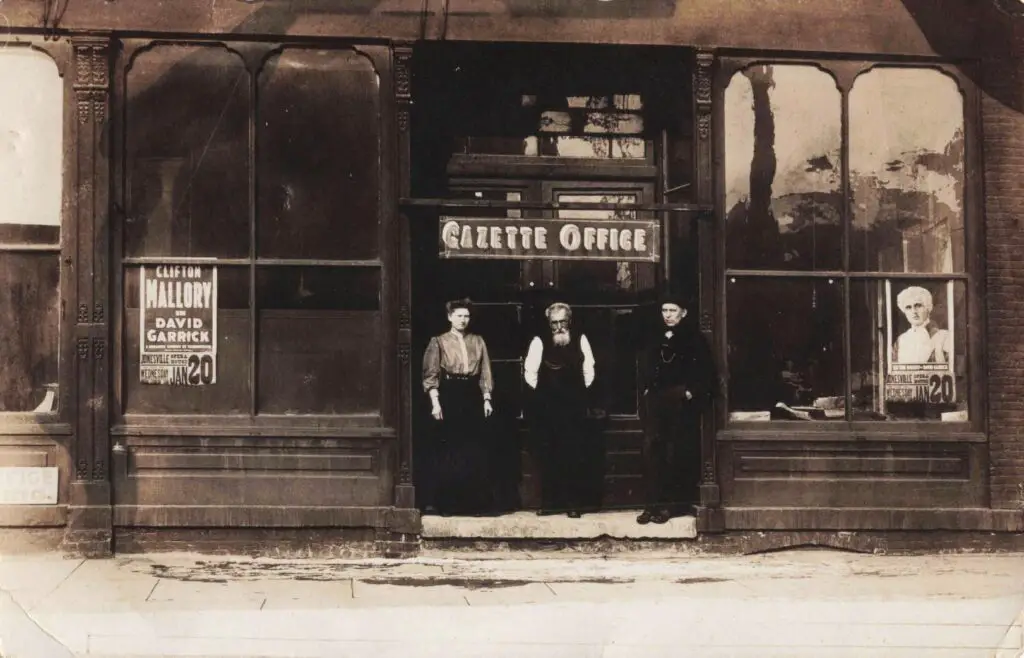
By the mid-20th century local news had shifted to the Hillsdale Daily News (which today covers Hillsdale County, including Jonesville), but in the early 1900s the Gazette was a vital civic institution.
Key Industries and Entrepreneurs
By the early 1900s several industries anchored the local economy. In this era Jonesville had cement manufacturing, a cigar factory, food processing plants, and hotels serving travelers. These firms created jobs for farmers and craftsmen in the area.
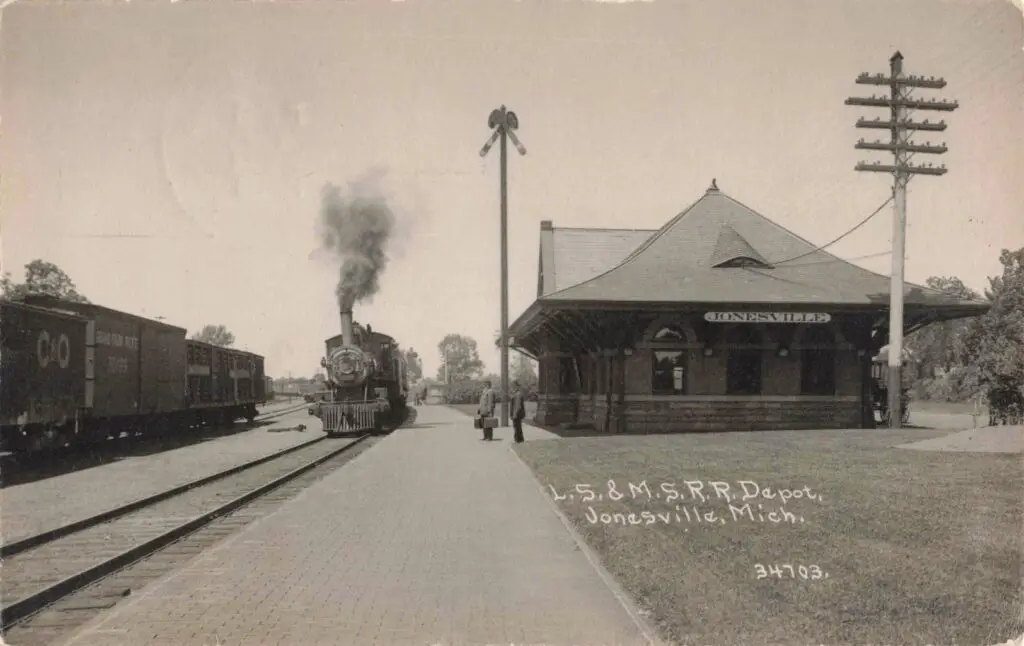
Railroads and Logistics: The railroad was more than transport; it employed men and connected Jonesville to markets. Men like stationmasters and warehouse clerks worked at the depot. Freight cars brought in coal and gypsum (needed for cement) and took out local products. The Fort Wayne & Jackson branch of the Lake Shore & Michigan Southern ran north of town, serving the nearby Omega Portland Cement work.
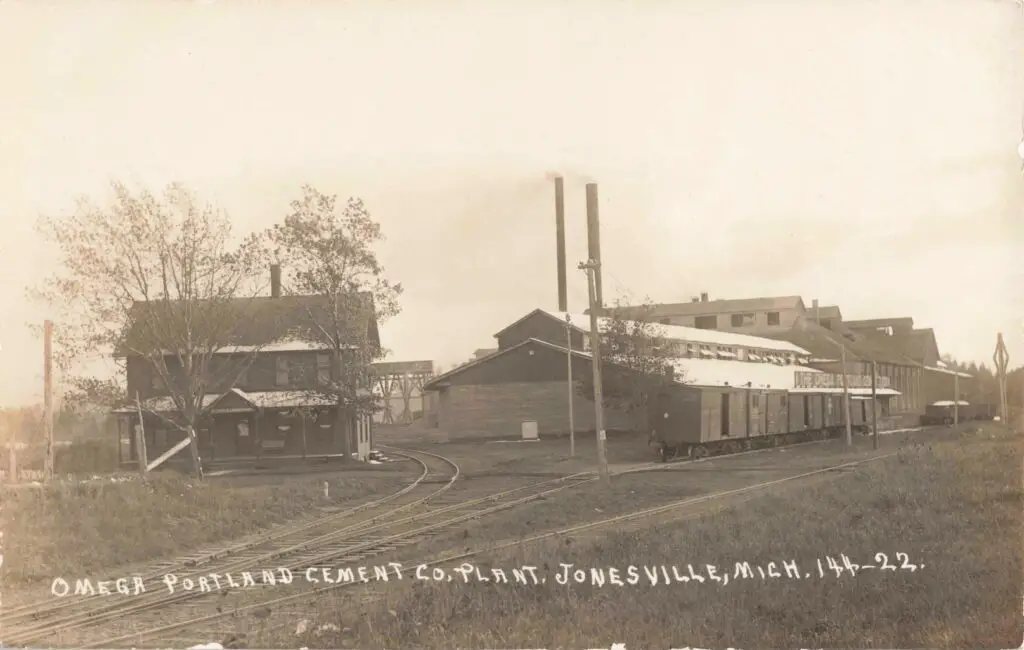
Omega Portland Cement (Mosherville): Northeast of Jonesville, near Cobb’s Lake, the Omega Portland Cement Company built a plant around 1899. Company offices were in Jonesville. The plant dredged marl from local lakes and blended it to make hydraulic cement. It reached full production about 1901.
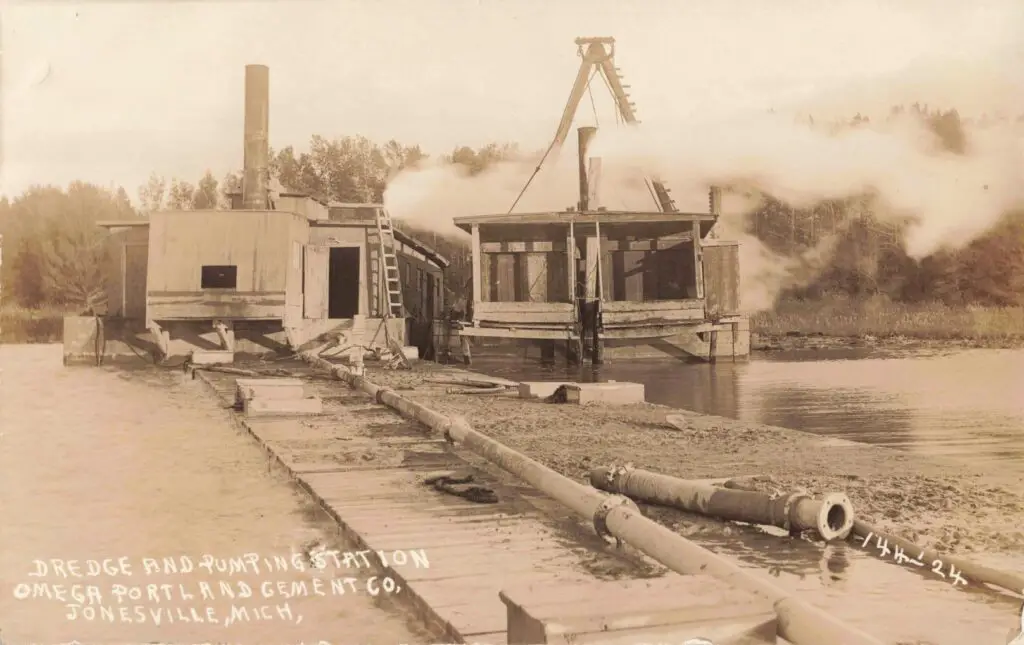
A steam dredge pulled marl out of Cobb Lake and fed it to the mill (as shown in period photos). This industry tied Jonesville to the region’s building boom, and the railroad delivered coal to fire its kilns. Frank M. Stewart led the company’s startup. However, by 1914 Omega’s operation wound down and the plant closed. (Today no cement plant remains at the site.)
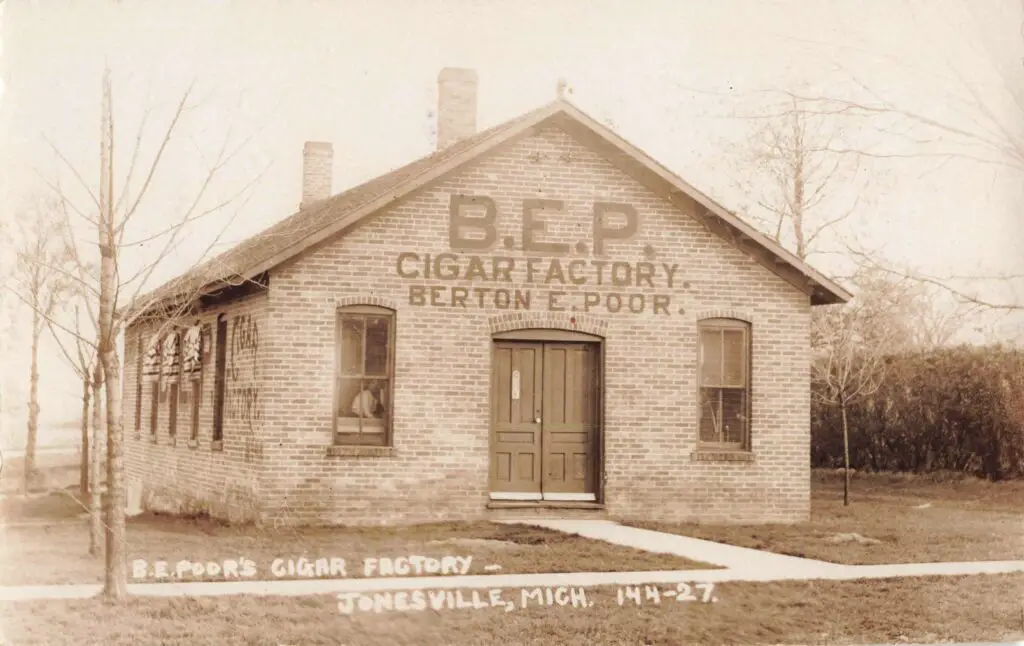
Cigar Manufacturing: Jonesville and neighboring Hillsdale had local cigar making. Berton E. Poor operated B. E. Poor’s Cigar Factory, producing the B.E.P. brand. In the photograph above, Poor’s cigar factory stands on Chicago Street with a company sign over the entrance. Workers in men’s and women’s attire are posed on the steps. Jonesville’s cigar trade was one of several small factories in town; the HCHS notes that Poor’s shop was “one of a number of cigar manufacturers in Jonesville and Hillsdale”. Tobacco came in by train or wagon; finished cigars were shipped out the same way. This was modest-scale industry, but important to Jonesville’s business district in the 1900s.
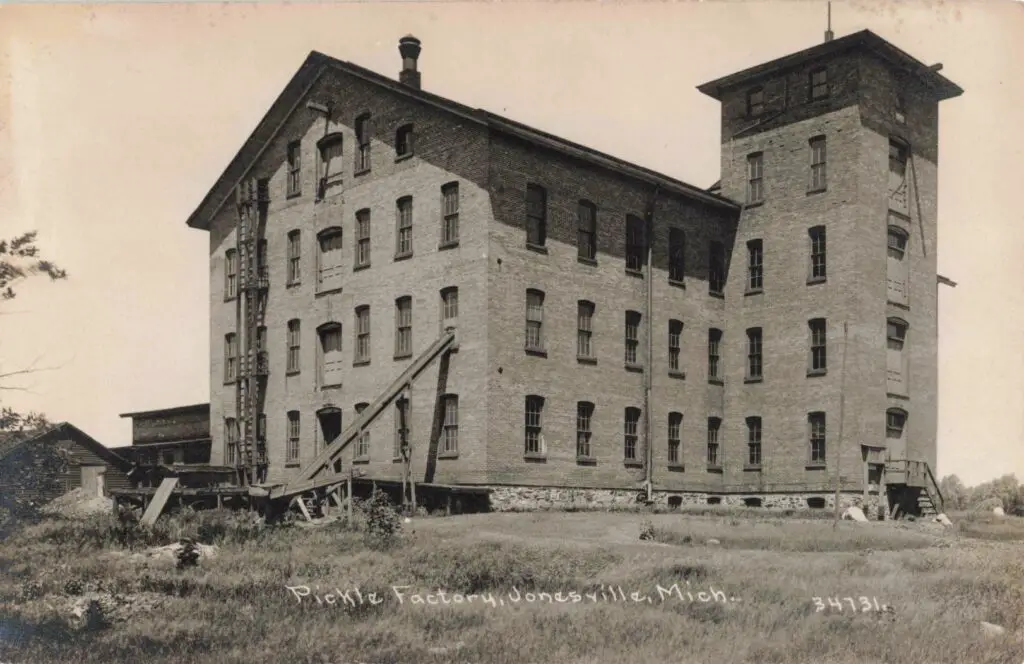
Food Processing – Pickles and Canning: Jonesville supported a sizeable pickle factory and related canning. One photo caption at the Hillsdale County Historical Society calls it “one of the greatest pickle industries in the county”. Cucumbers and cabbage (for sauerkraut) were packed in brine in large wooden vats. The pickle works stood near Mulberry and Riverside, using the river for transport in earlier years. Locals remember juggernaut barrels and vats at the plant in the 1900s. (By mid-20th century this factory closed or moved, and today only memories and historic photos remain.)
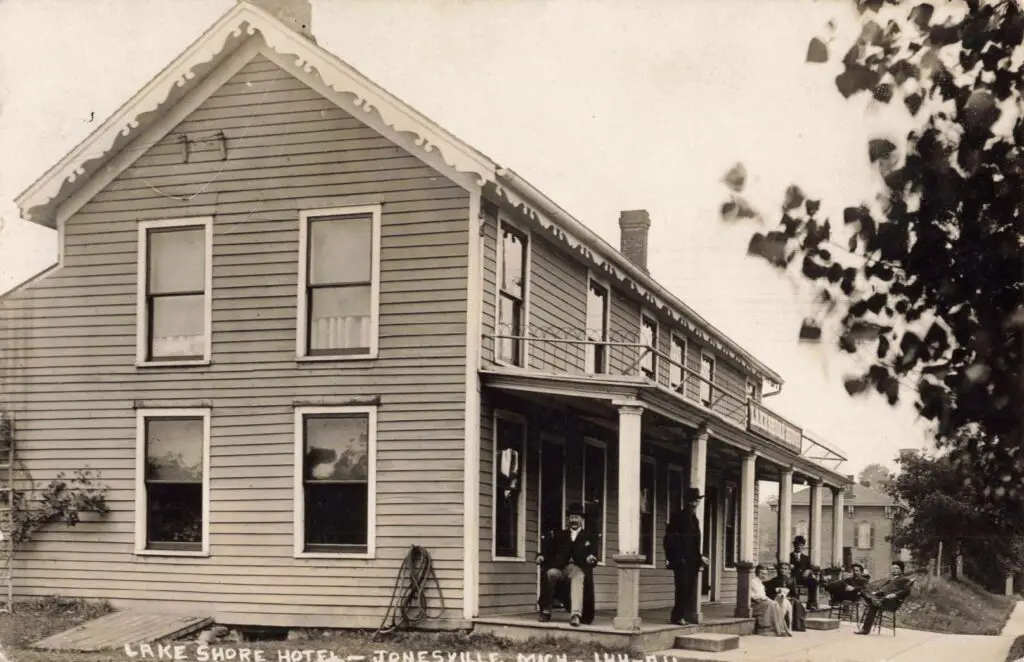
Hospitality: Travelers on US 12 and the trains needed lodging. By the 1890s Jonesville had at least one lakeside hotel. The Lake Shore Hotel (later called the Riverside) sat near a local lake to attract summer visitors. Anecdotes note that Cora and J.E. Abshier ran the Riverside Hotel from 1887–1924, serving rail travelers and vacationers. In an era before motels, this brick hotel (now gone) was a community hub for visitors. Like many small-town inns of that time, it closed by the 1930s, and the building was repurposed.
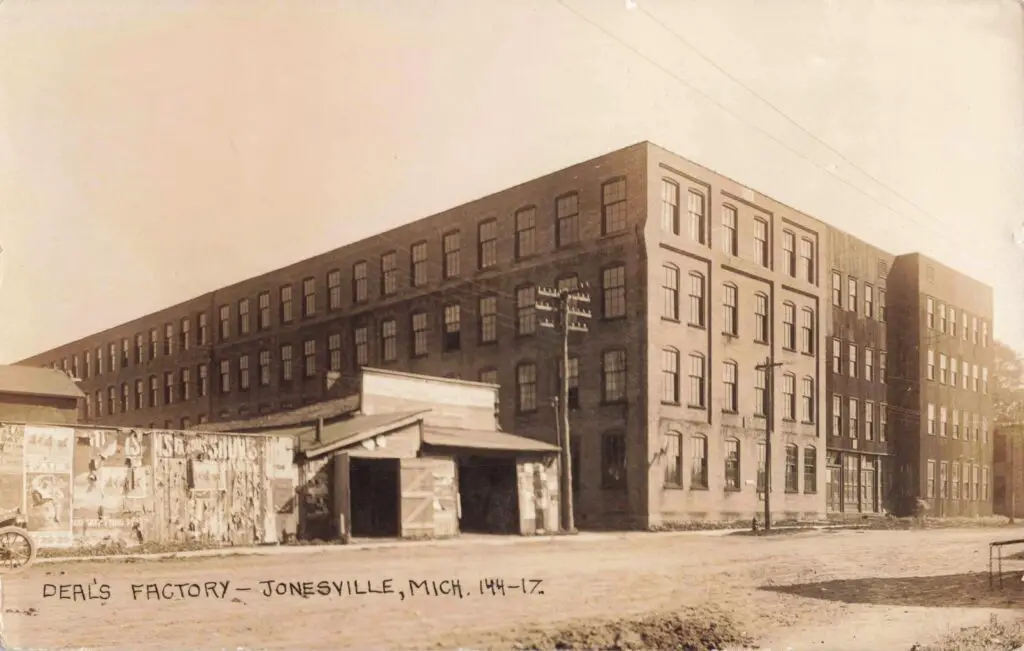
Other Manufacturing: In the late 1800s Jonesville also had woolen and cotton mills on Water Street; the Jonesville Woolen Mill burned in 1866 and was rebuilt. Carriage works (J.J. Deal & Son) and a toy factory operated on another corner of town, serving Michigan’s broader markets. These facilities employed dozens of skilled workers. By 1900 they were a source of pride, and some of their brick buildings survive today (the carriage works and toy plant is now a historic apartment building).
Community Life and Civic Institutions
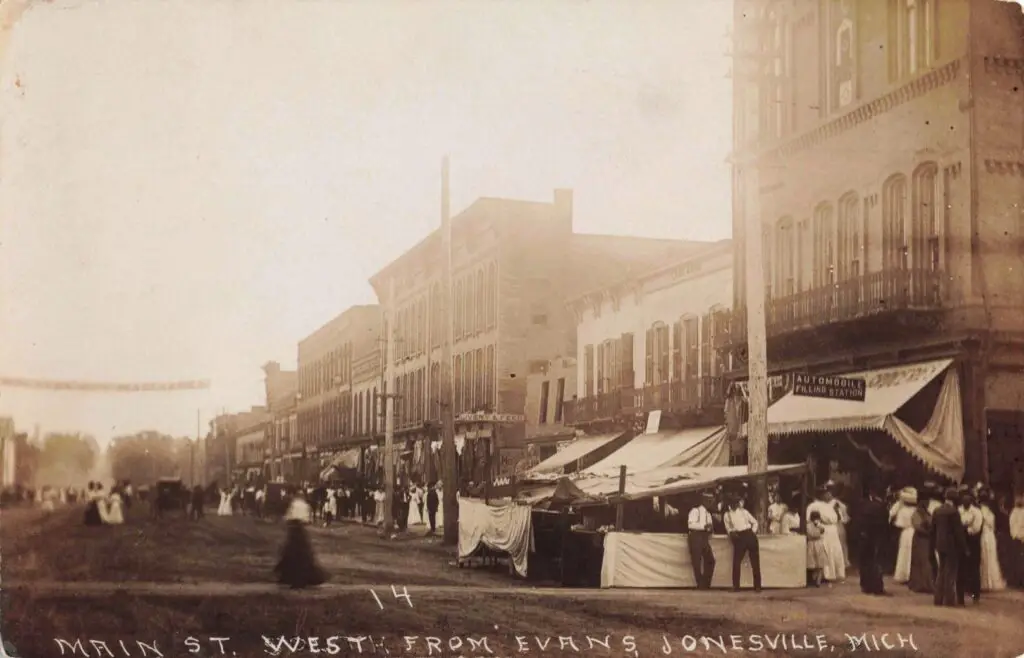
Life in 1900s Jonesville revolved around downtown Chicago Street, the river, and Main Street shops. Families read the county newspaper and joined fraternal lodges or church guilds. The Gazette office (shown above) printed news by hand and typeset. The Village Hall and Fire Station (also on Chicago Street) handled civic needs. Schools educated children and the old west bank area saw the first log schoolhouse (site of Beniah Jones’s cabin) replaced with a brick school by the late 1800s.
The Jonesville Hillsdale County Gazette was founded in 1839, making the town an early media center. In the 1900s it came out weekly, reporting on local courts, township meetings, and farm news. Over time, the Gazette merged into regional papers; by World War II local news was covered by the Hillsdale Daily News, which today still serves Jonesville and Hillsdale County.
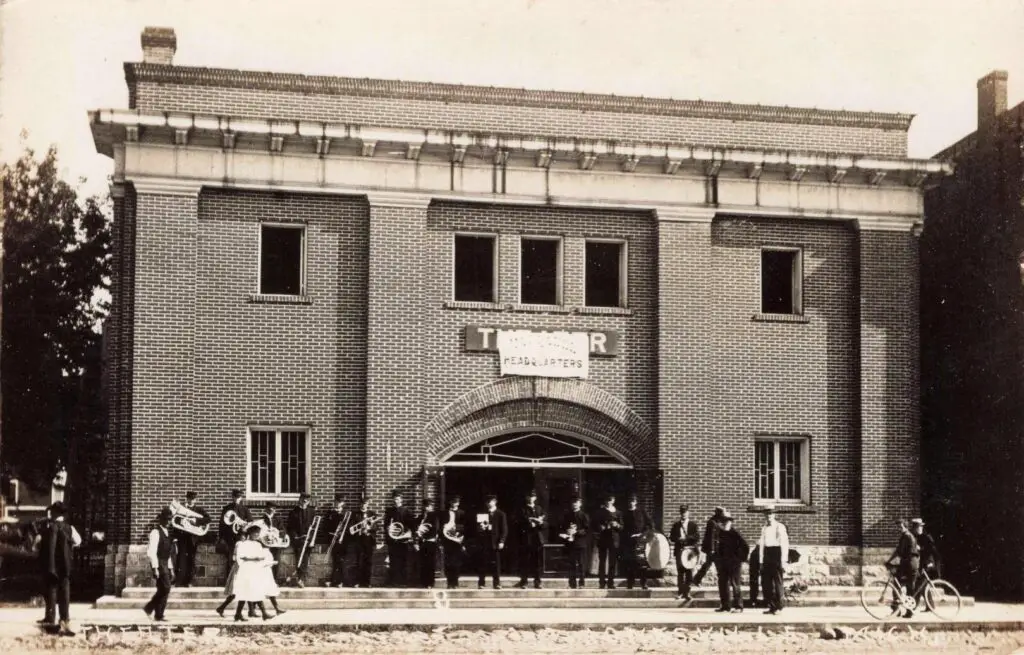
The postcard images from 1909 (Jonesville Theater) show formally dressed brass band and onlookers. They reflect a community confident in its future. Neighborhoods had streetcars of a sort (horse-drawn or early autos) and electric lights were introduced in the late 1890s. By 1910 Jonesville even had a small public library begun by club women in 1874 (later the District Library) and a Masonic Lodge on Broadway Street.
Change Over Time: Persistence and Loss
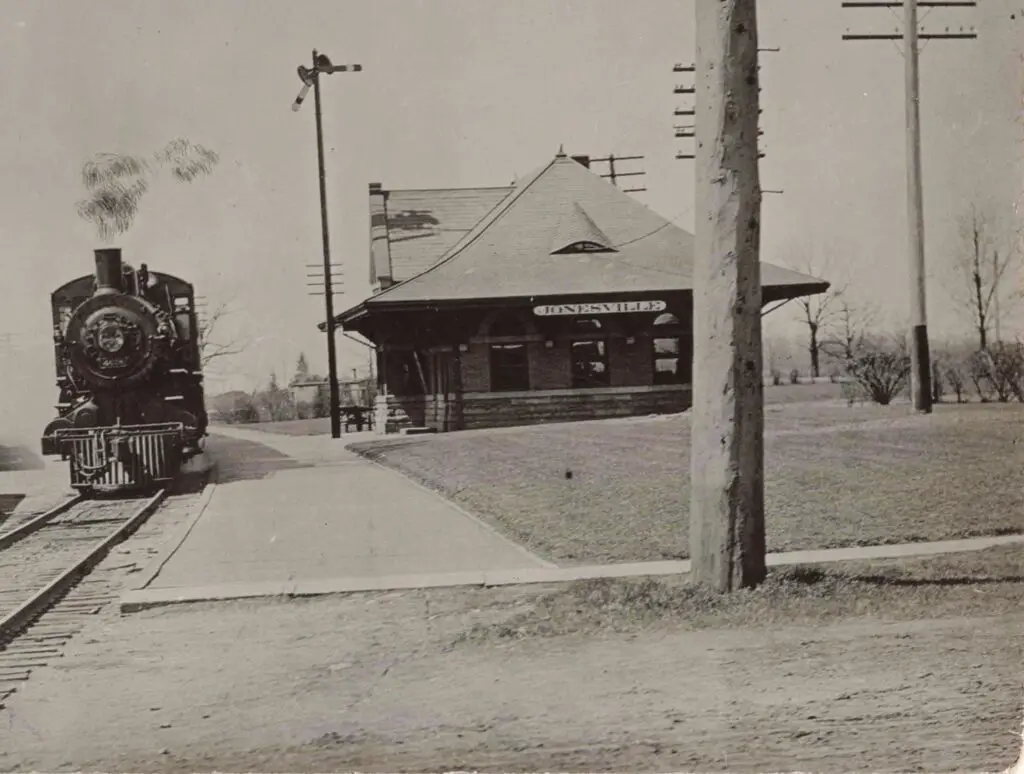
By 1920 Jonesville was still a stable small town, but its economy changed. The railroad station closed by the early 1920s as passenger service declined, and the tracks were eventually removed in some parts. The Omega Cement plant had shut down in 1914. Poor’s Cigar Factory did not survive the Depression era (no local cigar shops remained by 1950). The pickle factory continued a few decades but eventually closed or consolidated by mid-century. Hotels like the Lakeshore/Riverside also closed or were converted into boarding houses.
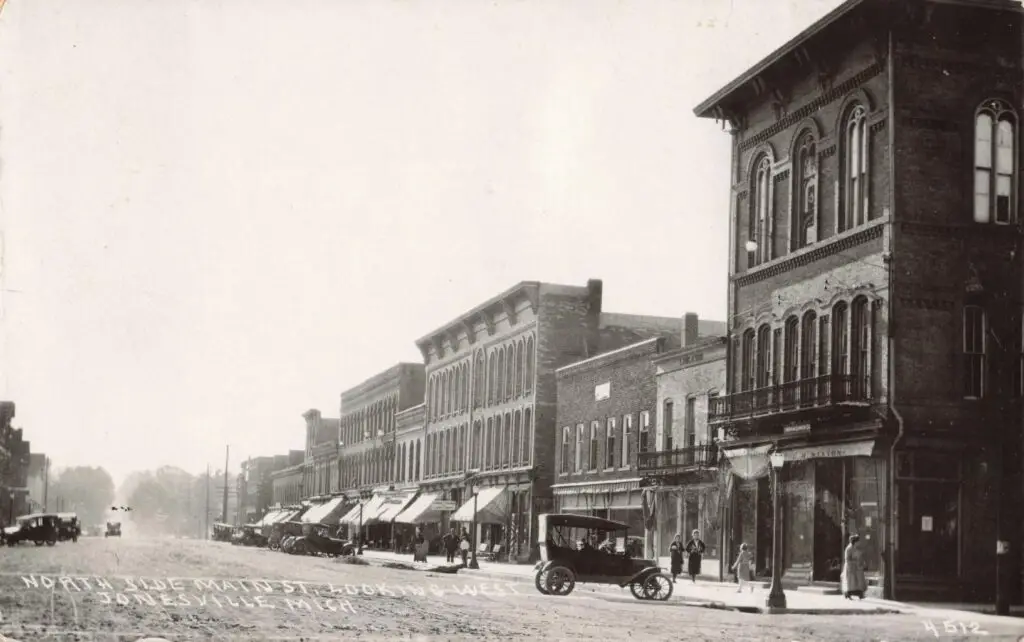
Meanwhile, some aspects of Jonesville endured. The streets laid out in 1831 remain the same, with US-12 still cutting through downtown. The old Woolen Mill site became a park (Millennium Park), and the railroad corridor is now greenway for walkers. Chicago Street still has turn-of-the-century buildings (including the former Deal Carriage factory, now repurposed). Churches from the 1800s still stand in quiet corners. The Jonesville area remains largely rural; farms still grow corn, beans, and wheat like they did in 1900, though tractors replaced horses long ago.
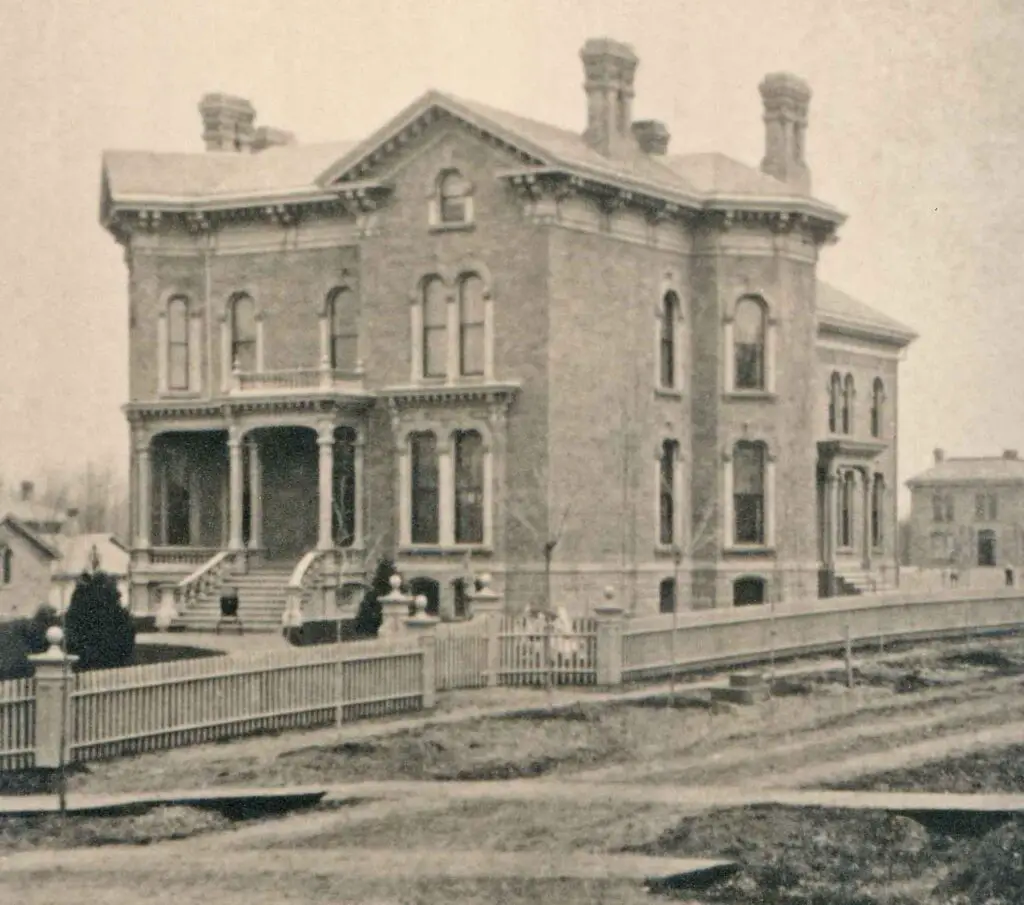
Today a visitor driving through sees a tidy village of about 2,200 people (almost exactly the same as 1980). Many local businesses are retail shops or services, not factories. The city proudly lists its history: the E.O. Grosvenor House (1874) and the Grace Episcopal Church (1871) on the historic register connect residents with Jonesville’s Victorian era. The old Gazette office building is now a law office on Chicago Street. The railroad right-of-way has become walking paths in parts, and trucks on US-12 carry on the shipping that once went by train.
Jonesville’s early-20th-century character survives in stories and landmarks. The Jones brothers’ names still grace the town. So do B.E. Poor’s cigarettes in old photo albums and label collectors’ pages. The tales of a big pickle factory at Riverside and a smokehouse on Chicago Street are told by grandchildren and in the local history museum. In sum, the hard work of those generations built the village we see today – even if the factories have quietly gone, their memory is woven into Jonesville’s ongoing story.
📚 Works Cited For the history of Jonesville Michigan
“B.E. Poor Cigar Factory, Jonesville.” Hillsdale County Historical Society. Accessed October 2025.
“Jonesville Rail Depot and Main Street Photographs.” David V. Tinder Collection of Michigan Photography, Bentley Historical Library, University of Michigan.
“Omega Portland Cement Company Records, 1899–1914.” Michigan State Archives.
“J.J. Deal & Son Carriage Factory / Deal Motor Vehicle Company.” Historic Vehicle Association Archive.
“History of Hillsdale County, Michigan.” Charles M. Skinner, 1903. Public Domain. Google Books Edition.
“Census of Population and Housing, 1900–1920: Hillsdale County.” U.S. Census Bureau.
“E.O. Grosvenor House and Grace Episcopal Church.” National Register of Historic Places.
